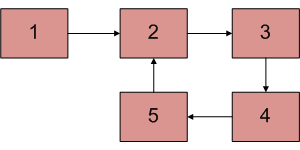
A (human) index that likes to code
Also drinks way too much coffee ![]()
Interview Experience - Part 2
Published Jun 19, 2019 12:00
Well; I told you - I would have had quite an experience and be able to make a blog post today.
I wanted to talk about one of the problems that was presented to me during the interview:
How do you figure out if a linked list is incorrectly looping?

Incorrect Looped Link List | Source: geeksforgeeks.com
There are so many possible answers to this solution. I came up with a solution which involves using a set object to store all the pointers, and check with the set to ensure that there are no duplicates. It’s a really bad algorithm, but I said it to answer the question. The interviewer’s (his) solution was more interesting, and is something that I haven’t encountered before - do keep in mind that I don’t indulge myself into algorithms in my diploma course and free time, because I’m more focused in actually trying to do something than to do it well.
Anyway, his algorithm was like this:
- Create two pointers,
Ptr1andPtr2; - Make
Ptr1andPtr2point at the same element; -
Ptr2will advance two steps per iteration, andPtr1will advance one step per iteration; - If any of the two pointers hit
NULL, then the algorithm proves that there are no loops in the linked list; -
Ptr1andPtr2will eventually collide in the loop, if neither pointer has hitNULL, it signifies that there is a loop in the linked list.
This blew my mind a little bit, and after hitting geeksforgeeks.org, this 5 step proceedure I described was actually one part of the Flyod’s Cycle detection algorithm (Flyod’s Cycle detection algorithm is completed in the subsequent steps). What really displaced what little intellectual points I had left in me was the next part:
How do you resolve the incorrectly looping linked list?
His algorithm was like this:
- Set
Ptr2back to the beginning of the linked list; - Let
Ptr1andPtr2go through the link list at the same speed, at one step per iteration; - Their first collision will be the beginning of the loop.
You may ask: wait, why is Step 3 true?
Let’s say Ptr1 travels x number of nodes within the linked list. This menas that Ptr2 travelled 2x number of nodes before it collides with Ptr1. What this also implies, is that if you were to let Ptr1 travel another x number of nodes, it will collide with Ptr2 again, as x + x = 2x, which is the same distance Ptr2 has travelled. Now, think about the distances travelled by Ptr1: it needed x number of nodes to collide with Ptr2 from the start of the linked list, and, by travelling another x number of nodes, it collides with Ptr2 again. This implies that if I were to have another pointer, called Ptr3, which travels at the same speed as Ptr1, with Ptr1 starting at the collision position and Ptr3 starting at the start, then Ptr1, Ptr2 and Ptr3 will collide at the same collision point. Meaning: the first collision point between Ptr1 and Ptr3 will signify the problematic node. If we were to make Ptr1 travel through the whole loop again, checking the next node pointed by Ptr1 to Ptr3, we can find the culprit causing the loop in the linked list, and route it to null.
In the above chunk of text, you realize that Ptr2 is only used to prove that Ptr1 and Ptr3’s first collision is the point where the loop begins. Hence, we can use Ptr2 instead of Ptr3, saving us one memory location.
That’s was interesting ain’t it?
One more thing I learned during the interview is the existance of a trie:
A trie | Source: Wikipedia
Which is helpful in search suggestions, especially if you have hundreds of thousands of such suggestions.
Well, I’ll probably not get what I interviewed for; but that’s fine. The experience taught me how it’s like to be interviewed for my technical skills; and helped me come up with possible strategies to try before my next interview.
Good luck for your own interviews, if they’re coming up!
Happy coding,
CodingIndex